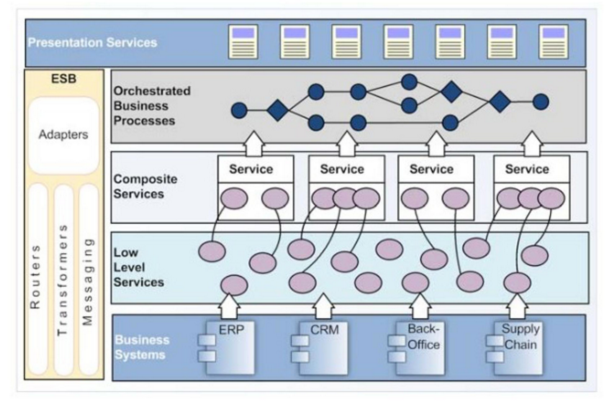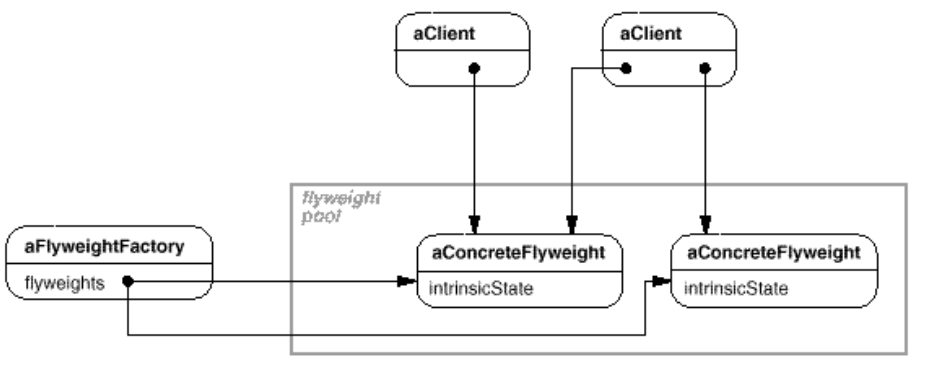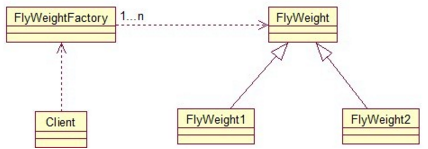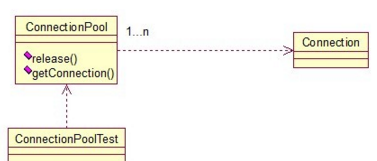11. Flyweight
- Intent:
- Use sharing to support large numbers of fine-grained objects efficiently.
What is the difference between coarse-grained and fine-grained?
Granularity is the extent to which a system is broken down into small parts, either the system itself or its description or observation. It is the extent to which a larger entity is subdivided. For example, a yard broken into inches has finer granularity than a yard broken into feet.
Coarse-grained - larger components than fine-grained, large subcomponents. Simply wraps one or more fine-grained services together into a more coarse-grained operation.
Fine-grained - smaller components of which the larger ones are composed, lowerlevel service

- Applicability:
- An application uses a large number of objects.
- Storage costs are high because of the sheer quantity of objects.
- Most object state can be made extrinsic.
- Many groups of objects may be replaced by relatively few shared objects once extrinsic state is removed.
- The application doesn’t depend on object identity. Since flyweight objects may be shared, identity tests will return true for conceptually distinct objects.
- Structure:


- Participants:
- Flyweight
- declares an interface through which flyweights can receive and act on extrinsic state.
- ConcreteFlyweight
- implements the Flyweight interface and adds storage for intrinsic state, if any. A ConcreteFlyweight object must be sharable. Any state it stores must be intrinsic; that is, it must be independent of the ConcreteFlyweight object’s context.
- UnsharedConcreteFlyweight
- not all Flyweight subclasses need to be shared. The Flyweight interface enables sharing; it doesn’t enforce it. It’s common for UnsharedConcreteFlyweight objects to have ConcreteFlyweight objects as children at some level in the flyweight object structure
- FlyweightFactory
- creates and manages flyweight objects.
- ensures that flyweights are shared properly. When a client requests a flyweight, the FlyweightFactory object supplies an existing instance or creates one, if none exists.
- Client
- maintains a reference to flyweight(s).
- computes or stores the extrinsic state of flyweight(s).
- Flyweight
- Collaborations
- State that a flyweight needs to function must be characterized as either intrinsic or extrinsic. Intrinsic state is stored in the ConcreteFlyweight object; extrinsic state is stored or computed by Client objects. Clients pass this state to the flyweight when they invoke its operations.
- Clients should not instantiate ConcreteFlyweights directly. Clients must obtain ConcreteFlyweight objects exclusively from the FlyweightFactory object to ensure they are shared properly.
- Consequences:
- the reduction in the total number of instances that comes from sharing
- the amount of intrinsic state per object
- whether extrinsic state is computed or stored.
Flyweights may introduce run-time costs associated with transferring, finding, and/or computing extrinsic state, especially if it was formerly stored as intrinsic state. However, such costs are offset by space savings, which increase as more flyweights are shared.
- Related Patterns:
- The Flyweight pattern is often combined with the Composite pattern to implement a logically hierarchical structure in terms of a directed-acyclic graph with shared leaf nodes.
- It’s often best to implement State and Strategy objects as flyweights.
- Code Sample: Flyweight


public class ConnectionPool {
private Vector<Connection> pool;
/*intrinsic state*/
private String url = "jdbc:mysql://localhost:3306/test";
private String username = "root";
private String password = "root";
private String driverClassName = "com.mysql.jdbc.Driver";
private int poolSize = 100;
private static ConnectionPool instance = null;
Connection conn = null;
/*constructor*/
private ConnectionPool() {
pool = new Vector<Connection>(poolSize);
for (int i = 0; i < poolSize; i++) {
try {
Class.forName(driverClassName);
conn = DriverManager.getConnection(url, username, password);
pool.add(conn);
} catch (ClassNotFoundException e) {
e.printStackTrace();
} catch (SQLException e) {
e.printStackTrace();
}
}
}
/* destroy */
public synchronized void release() {
pool.add(conn);
}
/* getter */
public synchronized Connection getConnection() {
if (pool.size() > 0) {
Connection conn = pool.get(0);
pool.remove(conn);
return conn;
} else {
return null;
}
}
}
